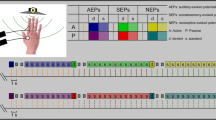Abstract
We investigated the effect of deviant stimulus probability on the somatosensory magnetic mismatch negativity (MMNm) using an electrical two-point stimulation. First, we determined the discrimination threshold (DT) of the two-point distance. We applied standard stimuli at a distance that subjects felt as one point and deviant stimuli at a distance that subjects definitely felt as two points. We used three deviant stimulus probabilities, 10, 30, and 50%. The components peaking around 30–70 ms (first component) and 150–250 ms (fourth component) following deviant stimuli were significantly larger than those following standard stimuli in 10% condition, but not in 30 or 50% condition. The equivalent current dipole (ECD) was located in the contralateral primary somatosensory cortex (cSI) for the first component, and in the cSI and in the contralateral secondary somatosensory cortex (cSII) for the fourth component. The peak amplitude of the MMNm decreased as the probability of the deviant stimulus increased. The Somatosensory MMNm was affected by deviant stimulus probability similar to an auditory mismatch negativity (MMN).







Similar content being viewed by others
References
Akatsuka K, Wasaka T, Nakata H, Inui K, Hoshiyama M, Kakigi R (2005) Mismatch responses related to temporal discrimination of somatosensory stimulation. Clin Neurophysiol 116:1930–1937
Akatsuka K, Wasaka T, Nakata H, Kida T, Hoshiyama M, Tamura Y, Kakigi R (2007) Objective examination for two-point stimulation using a somatosensory oddball paradigm: an MEG study. Clin Neurophysiol 118:403–411
Alho K, Woods DL, Algazi A, Knight RT, Näätänen R (1994) Lesions of frontal cortex diminish the auditory mismatch negativity. Electroencephalogr Clin Neurophysiol 91:353–362
Astikainen P, Ruusuvirta T, Korhonen T (2001) Somatosensory event-related potentials in the rabbit cerebral and cerebellar cortices: a correspondence with mismatch responses in humans. Neurosci Lett 298:222–224
Bonte M, Parviainen T, Hytonen K, Salmelin R (2006) Time course of top-down and bottom-up influences on syllable processing in the auditory cortex. Cereb Cortex 16:115–123
Hamalainen M, Hari R, Ilmoniemi RJ, Knuutila J, Lounasmaa OV (1993) Magnetoencephalography-theory, instrumentation, and applications to noninvasive studies of the working human brain. Rev Mod Phys 65:413–497
Hari R, Rif J, Tihonen J, Sams M (1992) Neuromagnetic mismatch fields to single and paired tones. Electroencephalogr Clin Neurophysiol 82:152–154
Hari R, Levanen S, Raij T (2000) Timing of human cortical functions during cognition: role of MEG. Trend Cogn Sci 4:455–462
Kekoni J, Hämäläinen H, Saarinen M, Gröhn J, Reinikainen K, Lehtokoski A, Näätänen R (1997) Rate effect and mismatch responses in the somatosensory system: ERP-recordings in humans. Biol Psychol 46:125–142
Levanen S, Ahonen A, Hari R, McEvoy L, Sams M (1996) Deviant auditory stimuli activate human left and right auditory cortex differently. Cereb Cortex 6:288–296
Molholm S, Martinez A, Ritter W, Javitt DC, Foxe JJ (2005) The neural circuitry of pre-attentive auditory change-detection: an fMRI study of pitch and duration mismatch negativity generators. Cereb Cortex 15:1609–1620
Näätänen R (1992) Attention and brain function. Lawrence Erlbaum Associates Hillsdale
Nakata H, Inui K, Wasaka T, Akatsuka K, Kakigi R (2005) Somato-motor inhibition processing in humans: a study with MEG and ERP. Eur J Neurosci 22:1784–1792
Nishitani N, Hari R (2002) Viewing lip forms: cortical dynamics. Neuron 36:1211–1220
Noguchi Y, Inui K, Kakigi R (2004) Temporal dynamics of neural adaptation effect in the human visual ventral stream. J Neurosci 24:6283–6290
Sato Y, Yabe H, Hiruma T, Sutoh T, Shinozaki N, Nashida T, Kaneko S (2000) The effect of deviant stimulus probability on the human mismatch process. Neuroreport 11:3703–3708
Shinozaki N, Yabe H, Sutoh T, Hiruma T, Kaneko S (1998) Somatosensory automatic responses to deviant stimuli. Brain Res Cogn Brain Res 7:165–171
Sonnadara RR, Alain C, Trainor LJ (2006) Effects of spatial separation and stimulus probability on the event-related potentials elicited by occasional changes in sound location. Brain Res 1071:175–185
Spackman LA, Boyd SG, Towell A (2007) Effects of stimulus frequency and duration on somatosensory discrimination response. Exp Brain Res 177:21–30
Tamura Y, Hoshiyama M, Inui K, Kakigi R (2003) Central mechanisms for two-point discrimination in humans. Neurosci Lett 342:187–190
Tamura Y, Hoshiyama M, Inui K, Nakata H, Wasaka T, Ojima S, Inoue K, Kakigi R (2004) Cognitive processes in two-point discrimination: an ERP study. Clin Neurophysiol 115:1875–1884
Tarkiainen A, Helenius P, Salmelin R (2003) Category-specific occipitotemporal activation during face perception in dyslexic individuals: an MEG study. Neuroimage 19:1194–1204
Wasaka T, Hoshiyama M, Nakata H, Nishihira Y, Kakigi R (2003) Gating of somatosensory evoked magnetic fields during the preparatory period of self-initiated finger movement. Neuroimage 20:1830–1838
Woldorff MG, Hillyard SA, Gallen CC, Hampson SR, Bloom FE (1998) Magnetoencephalographic recordings demonstrate attentional modulation of mismatch-related neural activity in human auditory cortex. Psychophysiology 35:283–292
Acknowledgments
We are grateful to Mr. O. Nagata and Mr. Y. Takeshima for technical help during the study. This study was supported by grants from the Japan Society for the Promotion of Science for Young Scientists to KA.
Author information
Authors and Affiliations
Corresponding author
Rights and permissions
About this article
Cite this article
Akatsuka, K., Wasaka, T., Nakata, H. et al. The effect of stimulus probability on the somatosensory mismatch field. Exp Brain Res 181, 607–614 (2007). https://doi.org/10.1007/s00221-007-0958-4
Received:
Accepted:
Published:
Issue Date:
DOI: https://doi.org/10.1007/s00221-007-0958-4




